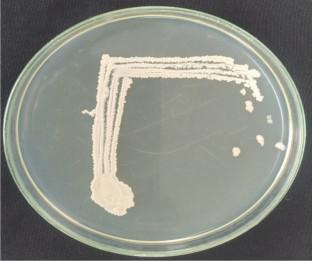Biomass Conversion and Biorefinery ( IF 3.5 ) Pub Date : 2024-02-06 , DOI: 10.1007/s13399-024-05365-z Kandasamy Selvam , Chinnappan Sudhakar , Arunagiri Ragu Prasath

|
In this study, Bacillus subtilis strain KSK02 consumed waste groundnut shell and Borassus flabellifer fruit husk to produce laccase using solid-state fermentation (SSF) by response surface methodology-Box-Behnken design (BBD-RSM). In order to enhance the biodegradability of groundnut shell waste (GNSW) and Borassus flabellifer fruit husk waste (BFFHW), the alkaline pre-treatment of both of these waste products was explored in this work. The morphological changes induced by the pre-treatment of both the GNSW and the BFFHW were characterized by scanning electron microscopy (SEM). The initial pH, incubation time, and concentrations of GNSW and BFFHW variables were designed for each fermentation condition of the B. subtilis strain KSK02 to enhance laccase production. B. subtilis strain KSK02 was able to produce a maximum production of amylase (423 U/mL) under optimal conditions during the fermentation process. These conditions included GNSW (2 g/L), BFEFBW (1.5 g/L), pH 7.0, and incubation time of 96 h. The maximum 89% decolorization was observed after 24 h of bacterial laccase treatment. The efficacy of the bacterial laccase in removing reactive red-120 (RR-120) from aqueous solutions using Vigna radiata seeds was demonstrated in the phytotoxic test. Molecular docking exhibited the binding affinity score of − 54.62 kcal/mol between the laccase-RR-120 dye complex. This study outlines statistically performed optimization approaches for improving bacterial laccase production, which resulted in a production system that is both high-yielding and cost-effective for a laccase with potential applications in textile color removal.
中文翻译:

利用双底物优化枯草芽孢杆菌菌株 KSK02 的漆酶生产及其活性红 120 染料降解潜力
在本研究中,枯草芽孢杆菌菌株 KSK02通过响应面法 - Box-Behnken 设计 (BBD-RSM) 采用固态发酵 (SSF)消耗废弃花生壳和Borassus flabellifer果壳来生产漆酶。为了提高花生壳废物(GNSW)和Borassus flabellifer果壳废物(BFFHW)的可生物降解性,本工作探索了这两种废物的碱性预处理。通过扫描电子显微镜 (SEM) 表征了 GNSW 和 BFFHW 预处理引起的形态变化。针对枯草芽孢杆菌菌株 KSK02的每种发酵条件设计了初始 pH、孵育时间以及 GNSW 和 BFFHW 变量的浓度,以提高漆酶产量。枯草芽孢杆菌菌株 KSK02 在发酵过程中的最佳条件下能够产生最大的淀粉酶产量 (423 U/mL)。这些条件包括 GNSW (2 g/L)、BFEFBW (1.5 g/L)、pH 7.0 和孵育时间 96 小时。细菌漆酶处理 24 小时后观察到最大脱色率为 89%。植物毒性试验证明了细菌漆酶使用绿豆种子从水溶液中去除活性红 120 (RR-120) 的功效。分子对接显示漆酶-RR-120染料复合物之间的结合亲和力得分为− 54.62 kcal/mol。这项研究概述了用于提高细菌漆酶生产的统计执行优化方法,从而形成了一个对于漆酶来说既高产又经济高效的生产系统,在纺织品脱色方面具有潜在的应用。


















































 京公网安备 11010802027423号
京公网安备 11010802027423号